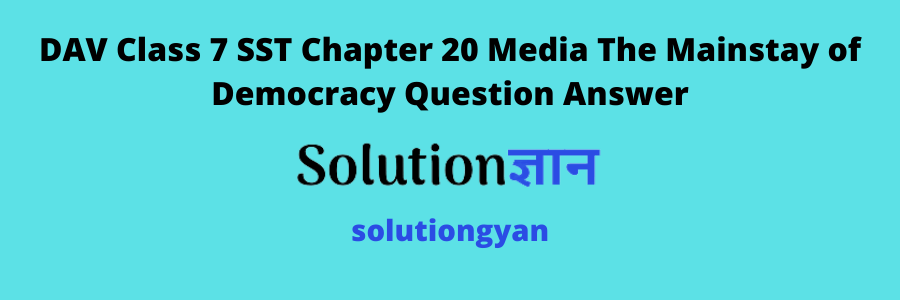If you are looking for DAV Class 7 SST Chapter 20 Media The Mainstay of Democracy Solutions of Social Science We and Our World book, then you are at right place. Here at solutiongyan, we provide complete solutions of DAV class 7 Social Science book.
Solutions of DAV Class 7 help to boost the writing skills of the students, along with their logical reasoning. These solutions for Class 7 are the most popular study material used by the students to refer for the DAV School exams.

If you are looking for more solution of DAV Public School book of sst of any classes then you can freely visit or check our site. We regularly update our site with new content every day. So, you can check it regularly for latest content.
DAV Class 7 SST Chapter 20 Media The Mainstay of Democracy Question Answer
DAV class 7 sst Book question answer chapter 20 Media The Mainstay of Democracy is given below. Here class 7 Social Science chapter 20 Question Answer is provided with great explanation.
In this chapter, students will learn about what an independent media means and how the media plays a vital role in setting up the agendas.
Highlights
D. Answer the following questions in brief.
E. Answer the following questions.
Class 7 SST Chapter 20 Solutions
A. Tick the correct option.
1. Paper was invented by the-
Answer: Chinese
2. The Right to Information has promoted-
Answer: accountability
3. Information provided by media should not be-
Answer: biased
4. Who among the following is NOT involved in the process of telecasting the news?
Answer: technician
5. Which country did Johannes Gutenberg belong to?
Answer: Germany
B. Fill in the blanks.
1. Media has brought ___________ to a level where technology is media.
2. Chinese influenced the development of ___________ by inventing paper.
3. Television affects public perception and ___________.
4. Media should not ___________ a class/person or an organisation.
5. The Right to Information has promoted ___________ and accountability.
Answer: (1) technology (2) printing (3) opinion (4) favour (5) transparency
C. State True or False for the following statements.
1. Media influences our beliefs and attitudes.
2. RTI was passed due to the demands of various organisations and movements.
3. Media is like a watchdog in a democracy.
4. Freedom of Speech and Expression has no limitation.
5. A very big share of Indian media is owned by political parties.
Answer: (1) True (2) True (3) True (4) False (5) False
D. Answer the following questions in brief.
1. Define Media.
Answer: Media refers to a various means of communication that help in communicating to a large number of people at a same time. For ex- radio, television, newspaper, etc.
2. Why is media called a watchdog of democracy?
Answer: Media is like a watchdog in democracy that keeps the government active and the people involved.
3. In what ways does the cinema affect our views?
Answer: Cinema played an important role creating awareness about social evils, economic exploitation and the fast-changing Indian society and its value system.
4. What are the different means of print and electronic media?
Answer: The different means of print media are books, newspaper, magazines and electronic media are television, radio, mobile phone etc.
5. What other basic rights are linked with the Right to Information?
Answer: The other basic rights linked with the Right to Information are freedom of speech and expression and right to education.
E. Answer the following questions.
1. How are media and technology dependent on each other?
Answer: The latest technologies help media to reach out to the masses. Technology has improved the efficiency of media and on the other, media updates us on the advances in technology. For example, media uses digital technology to provide improved quality of sound and picture as well as influences our thinking. It also helps us to think on global level, beyond the narrow boundaries of our country.
2. How does media influence our daily life?
Answer: The media helps in building public opinion by providing information to the public. Reports, editorials and letters published in the newspapers and magazines influence the public opinion. In the present time, it is the prime source for the public to know about the current affairs, sports and games, progress of wars, political situation in a country, etc. Thus, it has a great impact on the public perception and opinion.
3 Describe the role of media in a democracy.
Answer: In a democratic country, media plays an important role in the creating aware and enlightened citizens. Media has been successful in creating public opinion about the bride burning issues, exposing scandals and building the confidence of the people. It also ensures that the political power, and other powerful groups do not step beyond their limits. It is the main source of information. Interviews, speeches and panel discussions make viewers aware of the opinions of different political parties.
4. In what ways does the media bring the problems of the common man to the forefront?
Answer: The selection and the extent of media coverage by a television channel or a newspaper bring the problems of the common man to the forefront. It must constantly draw the attention of the public and the government towards issues like scarcity of clean drinking water, lack of health facilities in rural areas or over crowded cities, crime and violence, illiteracy etc.
5. Do you think Indian media is free? Justify your answer.
Answer: Yes, Indian media is free because our constitution safeguarded the ‘freedom of press’ as a fundamental Rights under freedom of speech and expression with some certain limitations in the interests of the public. But sometimes, the government can ban the media from broadcasting or publishing certain items to protect the interest of our country.

Also upload the solution of map skills
Thank you
Pls make ans smaller
Please upload map ????????️ skills solution too sir
Make it smaller
Thanks for the fact that you have provide us